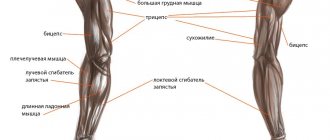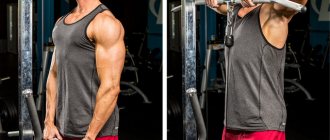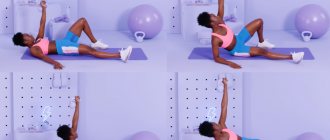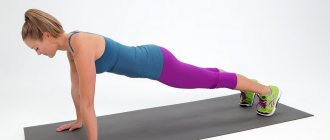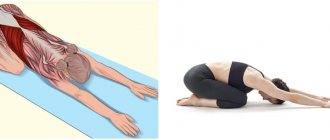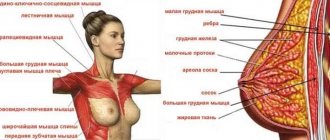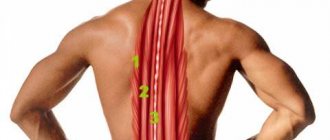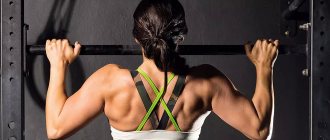Shoulder exercises help create a beautiful relief, neat contour and volume. But in this matter, the following are important: systematicity, a well-planned training program, and planned loads. You should choose the type of exercise that will allow you to work out the locally necessary muscle groups. But in order to know exactly what to focus on, you need to at least understand the anatomical structure of human shoulders.
Anatomy
The basis of the shoulder girdle is the deltoid muscles. Where the deltoid muscle of the shoulder is located can be seen in the photo below. It includes three separate muscle bundles - anterior, middle and posterior. Each of the bundles is responsible for a specific direction of movement in the shoulder joint:
- the anterior bundle contracts when the arm is raised forward in front of the body and when it is turned inward;
- the middle beam does the bulk of the work when raising the arms through the sides;
- the posterior bundle is responsible for abducting the arm down and extending it backward.
The layout of the delta muscles is shown in the photo. Thanks to the complex structure of the delta, the arms in the shoulder joints are able to make intricate multi-plane movements. Other large joints in the human body do not have this degree of freedom.
Anatomy of the shoulder muscles
Before developing a training program, you should study and understand the anatomy of the required area. The shoulder muscle is called the deltoid and is shaped like a triangle. It originates from the lateral part of the clavicle, the axis of the scapula and the acromion (lateral end of the scapula), attaching to the deltoid tuberosity of the humerus.
The delta consists of three main parts - bundles (also called heads), which have their own functions. They are directed towards the top of a downward triangle, shaped like a fan.
- FRONT OR FRONTAL. They are responsible for raising your arms (elbows) in front of you, bending your shoulder, turning it inward. Take part in presses for the muscles of the chest and shoulder girdle.
- MIDDLE OR LATERAL. Responsible for moving the arms to the sides. Actively participate in the seated barbell press.
- REAR. Responsible for raising the arms, extending the shoulder, turning it outward. Participate in pulling exercises for the back.
There is an excellent article on the topic of pumping up the rear delts - I recommend it.
In addition to giving a symmetrical figure and a beautiful silhouette, developed shoulder muscles also help to avoid injuries when working with heavy weights.
The right approach to training
To achieve maximum efficiency when pumping up your shoulders, you need to follow a few basic training rules. How to pump your shoulders correctly, watch the explanatory video at the end of the article.
Thorough warm-up
To prevent injuries and warm up the muscles and joint capsule, it is necessary to perform swinging movements with your arms without weights and up to 20 repetitions of basic exercises with light weights. As a result, light perspiration and a feeling of increased blood flow in the shoulder area should appear.
Ideal exercise technique
Accuracy and coordination of movements when pumping deltas is a prerequisite. Poor technique increases the risk of injury and robs the shoulders of some of the payload.
From general to specific
First, basic exercises are performed, then isolated movements to target the beams. In this way, the loading of all muscle fibers is achieved, providing a stimulus for increasing strength indicators and increasing mass.
Muscle failure
It is necessary to choose a weight that will allow you to complete the approach with maximum effort without compromising the technique of performing the exercise.
Anatomy of the rear delts and how to train them
The rear delta is located on the back of the shoulder, that is, at the back of the back. It starts from the lower edge of the scapula and, together with the other bundles, is attached to the tuberosity of the humerus.
Its functions include:
- Retracting the arm back in any plane.
- Rotation (turn) of the hand outward (towards the thumb).
Knowing the function of the rear delts, we now understand the mechanics of their work and how to train them. That is, the main exercises for us will be all kinds of deadlifts with different weights: barbells, dumbbells, cable trainer. But the main thing that we must understand is that in pulling movements the back is actively working, in particular the lats and trapezius.
rear delt exercises
What then should we do to eliminate the back from the exercise?
To begin with, we need to choose the optimal point where we will pull the training equipment we have chosen. Everything is simple here, if you consider that in any back exercises we pull the weight towards the belt, then when training the deltoids you will have to shift the emphasis closer to the chest. This will help eliminate the lats. I suggest, as a guide, to take the center of the pectoral muscles as that very point.
As for the position of the elbows. Basically, when training the rear deltas, the arms are held so that the elbows are in the same plane as the shoulders. That is, if we draw a horizontal line, then the elbows and rear delts will not go beyond it.
Next, you need to choose the right weight
It shouldn't be too light. This way we will simply drown our muscles, but this will not lead to their increase. As for heavy weight, it is also not welcome. Because the deltas will not be able to do it and the back will come to their aid, which will take all the load upon itself. So take the weight that you can pull only due to the force of the deltoids.
Basic exercises
The starting point for starting shoulder training is basic compound exercises. These are multi-joint movements that additionally target the muscles of the back, chest, legs and arms. They are especially important for developing the strength of the deltoids. Let's look at the best basic shoulder exercises that you can do in the gym and at home.
Bench press
This is the main barbell shoulder exercise. The middle and central deltoids are loaded, and the trapezius and triceps work indirectly. Sitting on a bench, hold the barbell with a medium grip behind your head at the base of your neck. Squeeze the bar upward, pointing your elbows straight to the sides. At the lowest point, the bar drops to the level of the base of the skull; the range of movement should not cause discomfort in the shoulder joints.
Front bench press
Variation of the previous exercise. In addition to the deltoids, the upper chest and triceps are also included in the work. In the starting position, the bar lies on the collarbones, elbows are brought forward. As you exhale, press the bar up. With a wide grip and spread elbows, the middle bundle is loaded more; with a narrow grip, the front bundle is connected.
Seated dumbbell press
The seated dumbbell press is the best basic shoulder exercise to do at home. The technique is similar to barbell presses. The target load falls on the middle and anterior deltoids; the trapezius, upper chest and triceps also work. There are options for both simultaneous two-handed and alternating presses. The ability to rotate dumbbells in the hands during movement additionally allows you to dynamically redistribute the load between the bundles.
Barbell row to the chin
A technically difficult exercise that requires good coordination. The main bias is towards the front and middle beams. In addition to them, the trapezius, biceps, forearms, abdominal muscles, lower back and buttocks are involved. In a standing position, hold the barbell in your lowered hands with a narrow grip. Pull the barbell up to neck level, pointing your elbows toward the ceiling.
It is important to avoid rocking your body - this can lead to injuries to the lumbar spine!
Top 6 shoulder exercises with dumbbells
The movements that allow you to pump up your shoulders with dumbbells at home are no different from the exercises performed in the gym. This makes them equally effective for progression, regardless of where you train.
Army press
The exercise is also called the dumbbell press. Can be performed with a barbell or dumbbells, in a sitting or standing position. Focuses the load on the front and middle beams. The key (and a common mistake even among advanced athletes) is the angle of the lift. When athletes pump their shoulders with dumbbells, the back of the bench does not rise to a strict 90 degrees, which places a considerable part of the load on the chest and front deltoids.
It is important to make the movement so that the body is in an upright position and the arms move straight up, which is facilitated by a standing position.
Technique:
- Take dumbbells and bend your elbows so that part of the dumbbell is near your front deltoid.
- Raise your arms up without a jerk, maintaining a slight bend in the elbow at the top.
- Lower the dumbbells to the starting position.
To pump up your shoulders more effectively with dumbbells, lifts should be performed alternately, with a neutral grip (palms facing each other).
"Bretch"
A powerful exercise that allows you to use a lot of weight. Effectively loads the front and middle beams. When performing with dumbbells, friction should be minimized (so that the plates of the apparatus do not cling to clothing, but slide over it).
Technique:
- Hold dumbbells at hip level with relaxed hands. The back is straight, feet shoulder-width apart (the body can be tilted forward 5-7 degrees).
- Start lifting the dumbbells so that they slide along your body. Elbows should point outward.
- Raise your arms up until your biceps are parallel to the floor.
Complex lift
The movement is similar to the Arnold Press, but performing this shoulder exercise at home with dumbbells is much safer and more effective. The only movement that loads all three bundles.
Technique:
- Take lightly weighted dumbbells. Stand up straight, arms down.
- Start pulling, and when you reach the top point, rotate at your elbows.
- Move the dumbbell from the lower position (the hand points down) to the upper position (the hand points up).
- Finish the movement with a classic standing press.
The exercise allows for effective development of the entire area when working with minimal weights, which means it is suitable for home use and for women.
Swing forward and sideways
These are the most popular exercises for building shoulders at home with dumbbells. They have the same type of technique, with the only difference being the direction in which the arms are raised.
- For the front deltoid, the swing is performed in front of you;
- for the middle beam – swing to the sides.
Technique:
- Stand straight, feet shoulder-width apart.
- Slowly and without jerking, lift the dumbbells forward (or to the sides) until your arm is parallel to the floor.
- Slowly return to the starting position.
Arm swings with dumbbells for middle deltoids
Swing your arms with dumbbells in front of you to your front deltoids
Bent over arms raise
The basic movement to pump your shoulders with dumbbells at home, focusing on the back bun.
Technique:
- Take the dumbbells in your hands and lean forward as deeply as possible (up to the level where your body is parallel to the floor). The back is flat, without strong rounding or arching.
- Begin to spread your arms out to the sides (with a slight bend at the elbow).
- At the peak point (when your arm is parallel to the floor), pause and return to the starting position.
It is important that the movement is performed only in the shoulder joint, with the elbow immobilized and the body fixed.
Arm abduction while lying down
Performed with minimal weights:
- Lie on your side with one arm (lower) behind your head to stabilize your body. Place your working limb forward so that the dumbbell is at the level of your lower shoulder.
- Slowly raise your arm (without moving your elbow) up, no more than 30 degrees above parallel to the floor.
Isolated exercises
After a heavy base load, spot work on each of the delta beams is necessary. Isolated mono-joint exercises with dumbbells or in simulators are intended for this purpose. Let's look at the most effective isolated exercises with dumbbells and on a crossover for pumping individual deltoids. Using a set of exercises with dumbbells, you can conduct a quality shoulder workout at home.
Standing dumbbell lateral raises
A variety of exercises for the shoulder muscles are effective swing-type exercises. Standing flyes are a popular isolated exercise for the middle deltas.
In a standing position at a slight inclination, we hold the dumbbells with our arms slightly bent at the elbows at the bottom, just in front of the hips. We swing our arms upward from the sides. At the top point, the arms are located slightly above parallel to the floor, the hands are turned with the thumbs down. To avoid injury, it is important to control the weight when lowering. There is an option to perform the exercise while sitting. Mastering the correct fly technique is the key to how to properly pump up your shoulder muscles with dumbbells.
Swing dumbbells in front of you
A simple exercise for the front deltoid with dumbbells allows you to concentrate as much as possible on the front beam. While standing, hold the dumbbells below with your arms outstretched in front of your hips. We make a swing movement with one hand forward. At the top point of the movement, the hand reaches parallel with the floor. After lowering the dumbbell to its original position, perform a similar movement with the other hand.
Bent-over dumbbell raises to the sides
How to pump up the rear deltas of the shoulder at home without complex equipment? One of the few exercises that allows you to effectively load the rear deltoids is bent-over dumbbell flyes. The trapezius and upper back are indirectly loaded. Standing at an angle of 70 to 90 degrees with a straight spine, hold the dumbbells below with slightly bent arms. We make swinging movements to the sides, pointing the elbows straight up and turning the hands with the thumbs down.
Lifting dumbbells to the reclining side
Unlike other swing movements, the maximum load in this exercise falls on the initial phase of the movement, which allows you to feel in detail the work of the middle delta beam. In a reclining position on your side on an inclined bench, hold the dumbbell in your outstretched arm below, touching your torso. Raise the dumbbell up, almost reaching the vertical. After completing the specified number of repetitions, flip over with one arm and continue working on the other side.
Flying your arms back in the butterfly simulator
Despite the fact that the basis of rear delt training is exercises with dumbbells, using a butterfly machine also allows you to effectively load hard-to-reach areas of the muscle. Sitting on the bench of the exercise machine, we rest our chest against its back. Holding the handles with your elbows bent, we spread our arms back, trying to close our shoulder blades at the end point.
Working in a crossover
We figured out the question of how to properly pump your shoulders with dumbbells at home. But in addition to dumbbells, all isolated swing exercises can be performed in block crossovers. The use of exercise machines will allow you to further diversify the load and exclude non-target muscle groups from work.
How to pump up your shoulders at home
Preparing the body for training
For warming up, dynamic bodyweight exercises performed at a slow pace and with awareness of movement are best. Warm-up is usually done “from top to bottom” - from the head to the feet, and “from the periphery to the center” - from the fingers to the torso. Before training the shoulder muscles at home or in the gym, a warm-up is required.
- Stretching the neck muscles.
- Press your chin to your chest, stretching the muscles, and hold for 10-15 seconds. Tilt your head back and hold for 10-15 seconds. Repeat each movement 2-3 times.
- Place your palm on the top of your head, holding it with your hand, slowly lower your head to the side, stretch your ear to your shoulder. There is no need to touch the shoulder, it is only important to stretch the muscle for 20-30 seconds. Repeat for each side 3-4 times.
- Keeping your chin still, turn your head to the side and stretch the muscle for 5-10 seconds. Repeat for each side 3-4 times.
A complete complex about training the neck muscles. Which will serve as a supplement when a skinny guy gains muscle mass.
- Shoulder girdle
- Hands along the body. Clench and unclench your fists 3-4 times, then perform three adductions and abductions of the fist.
- Rotate your fists for 3-5 seconds in each direction.
- Stretch your arms a little. rotation in the elbow joint for 3-5 seconds in each direction.
- Rotational movements in the shoulder joint. Two variations, in each, when rotating the shoulders forward - exhale, when moving back, when expanding the chest - inhale 1) Arms along the body, palms facing you. The shoulder turn is done in such a way that the back of the hand is turned forward and the palm is turned back.
- Torso
- Relax your arms down, turn your body so that the relaxed arms, swinging, help the body twist. Repeat three times in each direction.
- Place your palms on the back of your head, moving your bent elbows to the side. Pull your elbows back for 20-30 seconds, stretching your pectoral muscles, then try to bring your elbows together in front of your face, tightening your pectoral muscles, and hold for 20-30 seconds.
- One hand is on the belt, the second is straightened above the head. Slowly tilt towards the raised hand, then change hands. Hold for 15-20 seconds, repeat 3 times for each side.
Shoulder program with dumbbells
For all exercises of the complex, the execution is slow, at the top point there is a delay, at the bottom point the muscles do not relax, and the hand is nothing more than a lever that transfers the load to the shoulder muscles. All joints except the shoulder are immobile
- Lifting weights in front of you (front deltoids) IP – Neanderthal stance: legs slightly bent at the knees, feet parallel, 20 cm between them. Arms straight, lowered down and slightly bent at the elbows. The palms are turned so that the backs of the hands are facing forward, and the dumbbells are held near the front of the thighs. The body is straightened and slightly tilted forward, the back is fixed, the abs are tense.
- Without straightening the elbow, with a movement only at the shoulder joint, while exhaling, raise your arms slightly above your shoulders (to the maximum achieved without engaging the torso muscles).
- Slowly and under control, as you exhale, lower the dumbbells, without completely relaxing your arms.
Recommended 3 sets of 8-10 times. You can complicate the exercise if you lift not dumbbells in front of you, but a barbell plate (pinch grip) or one dumbbell, holding it by the heads (discs). Since the arms are strongly contracted, you cannot raise them above shoulder level. Lifting in front of you can be done alternately.
- Raising dumbbells overhead (middle delts). IP - Neanderthal stance.
- Without bending your elbows, while inhaling, raise the dumbbells first straight in front of you.
- Without pause or jerk, continue the movement, lifting the dumbbells above your head.
- In the upper position, at the most tense delta, there is a delay.
- Slow, controlled lowering while exhaling.
This is not a dumbbell shoulder press; the described variation requires a much lighter weight of dumbbells.
The dumbbell describes an arc (half a circle). The exercise is a continuation of a simple lift in front of you, but is not performed in isolation, but by engaging the assistant muscles of the torso. Recommended 3 sets of 15 repetitions
- Raising dumbbells to the sides (medium deltoids). IP - Standing.
- Keeping your back arched, slowly raise your arms with dumbbells up, while they describe arcs (a quarter of a circle).
- Raise to the line or not much above the line of the shoulders (otherwise the trapezius will turn on).
- At the top of the movement, turn the palms with the thumb up (load on the front head), strictly to the floor (the front and middle heads are loaded), or back and to the sides (little finger up, then the entire load goes to the middle head).
The projectile is controlled at all times, the elbow and torso are always motionless. This technique involves the middle and anterior fascicles; turning the hand allows you to increase the amplitude. 3 sets of 20 repetitions are recommended. The second basic and third isolating exercises are aimed at pumping up shoulder width with dumbbells at home.
- Bent over raise (this is how the rear delts swing). IP – Bent-over stand. Hold dumbbells with your hands facing your sides. Straighten your back, bend a little in the lower back, pull in your stomach, fix your posture. Bend your knees and lean forward with your back straight, bending your lower back a little more, bringing your torso almost parallel to the floor. Fix this position of the spine. Hands with dumbbells are slightly bent at the elbows and lowered down.
- Raise your arms straight to the level of your back, moving the dumbbells in a vertical arc. If the back of the hand looks straight up, the rear delta and partly the middle delta are loaded. If you unfold the top of your little finger, the trapezius and back muscles are loaded.
- Raise and move your arms forward a little (the front delta is loaded).
4 sets of 10 repetitions are recommended. You can complicate the exercise by raising your arms not from the sides to the side, but straight forward to shoulder level (the knuckles of the fist will be directed forward, the palms will be turned towards each other). The front and middle beams, upper trapezius and back, and corset muscles are trained. The rear deltoid is weakly involved.
How to build shoulder mass
To pump up massive shoulders, the following rules apply:
- use of heavy weights;
- a small number of repetitions in a series (from 6 to 10);
- The duration of rest between series is about 2 minutes.
Let's look at a typical exercise program for pumping up deltoid mass. These are the most effective exercises, which are the key to how to properly pump up your shoulders for mass.
- Bench press sitting behind the head. In 4 series we perform from 6 to 10 repetitions, with an interval of 2 minutes between series.
- Barbell row to the chin. In 3 series we perform from 6 to 10 repetitions, with an interval of 2 minutes between series.
- Bent-over dumbbell raises to the sides. In 3 series we perform 8 repetitions, with an interval of 90 seconds between series.
- Standing dumbbell lateral raises. In 3 series we perform 8 repetitions, with an interval of 90 seconds between series.
Work on the relief
To achieve relief and separation of deltas, the following postulates must be observed:
- use of average weights (from 50 to 70% of the maximum);
- number of repetitions in a series from 10 to 12;
- the use of super series, when two exercises are performed at once during a series without rest between them;
- The duration of rest between series is no more than 90 seconds.
A typical delta workout for relief looks like this:
- Bench press in front of you. In 4 series we perform from 10 to 12 repetitions, with an interval of 90 seconds between series.
- Dumbbell lateral raises while standing and bent over raises (super series). In 4 super series, we perform 10 repetitions of each exercise, with an interval of 60 seconds between super series.
- Swing dumbbells in front of you. In 4 series we perform 12 repetitions, with an interval of 50 seconds between series.
- Lifting the dumbbell towards a reclining position. In 4 series, we perform 10 repetitions without rest (one side of the body rests while pumping the other).
Rear delts
How to pump up the rear delts when they are lagging behind? It is necessary to perform maximum movements that force the posterior bundle to work. The specialized program includes the best rear delt exercises in the gym and looks like this:
- Bench press. In 4 series we perform from 6 to 10 repetitions, with an interval of 2 minutes between series.
- Bent-over dumbbell raises to the sides. In 4 series we perform from 7 to 10 repetitions, with an interval of 90 seconds between series.
- Raising your arms to the sides while standing in a crossover. In 3 series we perform from 8 to 10 repetitions, with an interval of 90 seconds between series.
- Raising your arms back in the butterfly simulator. In 3 series we perform from 8 to 10 repetitions, with an interval of 90 seconds between series.
A set of workouts for men
I will write a program that I think is the most effective for building shoulders with dumbbells, which will suit most men . But this does not mean that with the help of this training, every owner of narrow shoulders will become a machine.
I encourage you to use this dumbbell shoulder exercise program as a template and experiment a little with your choice of exercises.
- Seated dumbbell press, 4 sets of 8-12 reps.
- Standing one-arm dumbbell press, 4 sets of 8-12 reps.
- Side swings with dumbbells to the sides, 4 sets of 12-16 reps.
- Bent over dumbbell rows, elbows out to the sides, 4 sets of 8-12 reps.
- Side bend swings, 4 sets of 10-12 reps.
This complex contains three basic movements and two isolating ones. In basic exercises we give it our all, but in isolation exercises we work it to the end so that we couldn’t even hold a snake in our hand.
Middle deltas
A set of exercises with an emphasis on the middle deltoids includes the following:
- Barbell row to the chin. In 4 series we perform from 8 to 10 repetitions, with an interval of 2 minutes between series.
- Bench press. In 3 series we perform from 8 to 10 repetitions, with an interval of 2 minutes between series.
- Standing dumbbell lateral raises. In 4 series we perform from 8 to 10 repetitions, with an interval of 90 seconds between series.
- Lifting the dumbbell towards a reclining position. In 4 series we perform 8 repetitions, with an interval of 60 seconds between series.
Front delts
The anterior delta bundle rarely requires specialized loading. It is involved in all pressing movements and is in most cases well developed. If you need to work it out in depth, it is enough to regularly include in your training barbell rows to the chin and swinging dumbbells in front of you in 4 series of 8-10 repetitions.
